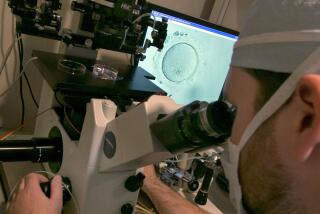Options Available to Infertile Couples
Sherry King, 34 and the mother of a 3-year-old daughter, gave birth recently to a second girl she prefers to call her âniece.â The baby is, actually, a biological half-sister to the older child. She is the product of artificial insemination, with the sperm of her sisterâs husband. There were four adults in the delivery room--Sherry, her husband (who bears no genetic relationship to the child), her older sister Carolee (unable to have a child because she had had a hysterectomy at 21), and Caroleeâs husband, the father of the child--and Sherry handed the infant to her sister before its umbilical cord had been cut.
Sherry King describes her experience as a surrogate mother in Omni magazine, asserting that she will always love the baby. She dismisses any problem that little Kristen may have, insisting that âshe will grow up knowing about her conception--for her it will be a fact of life.â
There has been an enormous amount of publicity about different options available to infertile parents. Most controversial, but actually the least complicated from a legal or ethical point of view, is in vitro fertilization when the egg and sperm come from the parents who will raise the child. In this case the embryo is implanted in the womb of the mother who donated her egg. More complicated is the option of implanting the same embryo in the womb of another woman who will then be the âgestationâ mother, providing sound nutrition and whatever else a fetus needs to develop into a baby. This option, along with fertility drugs that enable a woman to release eggs when she is trying to become pregnant, are the products of new biotechnology.
A Mixed Message
Sherryâs decision to bear a child for her sister is not. Artificial insemination has been around for at least 50 years. Before that, it was not beyond the realm of possibility for a sister to become pregnant by her brother-in-law the old-fashioned way. What is new is Mrs. Kingâs fervor in proclaiming that this is a good thing.
I suspect that neither of Kristenâs mothers are aware that they are sending out a mixed message. On one hand Sherry is denying biological truth. She insists that Kristen is her niece. But Kristen is her daughter. She has given her new-born daughter to her sister for adoption. This was facilitated by the fact that Kristenâs father is not Mr. King, so he presumably did not mind parting with her. Caroleeâs husband is Kristenâs father, and so he accepted his own offspring.
On the other hand, Sherry is promoting genetic parenthood as the best option. Blithely assuming that Kristen will find the situation normal as she grows up, she has not considered the possibility that Kristen may find her identity puzzling.
New Parental Morality
The new parental morality that Sherry King promotes seems to demonstrate a certain lack of concern for the children. The parents seem preoccupied with having their âownâ baby as if people do, in fact, own their children.
It is hard not to sympathize with barren women. Rearing children has been for me, and for most parents I know, a most exciting and pleasurable long-term experience. I have not noticed that the many adoptive parents I know have found it any less rewarding. Parents of adopted children clearly love their youngsters every bit as much as biological parents. It could be argued that the ability to love a non-related child is one of the qualities that distinguishes human beings from all other mammals.
If a genetic connection is so crucial to some parents that they are willing to go to extreme expense and hardship to obtain a biological child, do they expect that child to mirror themselves, to be a veritable âchip off the old block?â
I suppose we are much closer to the rest of the animal world than I used to believe. In the only species that we know of besides ourselves where mothers nurse and care for the offspring of maimed or dead mothers, the adoptive mothers are inevitably aunts or sisters of the orphans. They are thus, in terms of simple biological self-interest, preserving the genetic contribution of their kin, creatures with a somewhat similar set of genes and chromosomes, very much like the situation in the King family.
There are still myriad babies and children available for adoption who will grow up in a series of foster homes or worse, on the street, while desperate parents-to-be explore the possibilities of surrogate parenthood. Like the chimpanzees, lions and baboons in the Serengeti, human beings will allow unrelated infants of their own species to languish while they seek desperately to perpetuate their own DNA.
More to Read
Sign up for Essential California
The most important California stories and recommendations in your inbox every morning.
You may occasionally receive promotional content from the Los Angeles Times.










